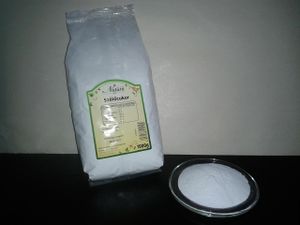Glucose
 Store-grade glucose.
| |
| Names | |
|---|---|
| IUPAC name
D-Glucose
| |
| Systematic IUPAC name
(2R,3S,4R,5R)-2,3,4,5,6-Pentahydroxyhexanal | |
| Other names
Blood sugar
Corn sugar Dextrose D-Glucose Grape sugar | |
| Identifiers | |
| Jmol-3D images | Image |
| |
| Properties | |
| C6H12O6 | |
| Molar mass | 180.16 g/mol |
| Appearance | White crystalline solid |
| Odor | Odorless |
| Density | 1.54 g/cm3 |
| Melting point | α-D-glucose: 146 °C (295 °F; 419 K) β-D-glucose: 150 °C (302 °F; 423 K) |
| Boiling point | Decomposes |
| 90.9 g/100 ml (at 25 °C) | |
| Solubility | Slightly soluble in alcohols Insoluble in esters, ethers, hydrocarbons, halocarbons |
| Vapor pressure | ~0 mmHg |
| Thermochemistry | |
| Std molar
entropy (S |
209.2 J·K−1 ·mol−1 |
| Std enthalpy of
formation (ΔfH |
1271 kJ/mol |
| Hazards | |
| Safety data sheet | AcrosOrganics |
| Related compounds | |
| Related compounds
|
Fructose Tagatose |
| Except where otherwise noted, data are given for materials in their standard state (at 25 °C [77 °F], 100 kPa). | |
| Infobox references | |
Glucose (occasionally referred to as grape sugar) is an organic compound with the molecular formula C6H12O6, found in sugar. Glucose is classified as a sugar, a monosaccharide, more specifically a hexose (6 carbon atoms).
Glucose has 16 stereoisomers, with the D-isomer or D-glucose, also known as dextrose, being the most important. It is one of the few isomers that occur widely in nature.
Contents
Properties
Chemical
Glucose is the ubiquitous fuel in practically all biological organisms.
Physical
Glucose is an odorless, colorless white solid, with a sweet taste, very soluble in water, acetic acid, but less so in ethanol and methanol, and insoluble in most non-polar solvents, like hydrocarbons.
Availability
Glucose bars can be purchased from most stores. Purification may be required to remove additives or other contaminants.
Powdered glucose can be purchased from pharmacy and some food stores.
Glucose is made during photosynthesis from water and carbon dioxide, using energy from sunlight.
Preparation
Glucose is produced commercially via the enzymatic hydrolysis of starch, with corn starch being the most common form of starch used, though other sources of starch can be used.
Inversion of sucrose (table sugar) will yield glucose and fructose. This can be achieved by heating a mixture of water:sucrose in a ratio of 1:2, with 0.1% citric acid added as a catalyst (though other acids can be used, such as ascorbic acid or potassium bitartrate). The solution is heated up to 114 °C for a few hours for complete separation of the two monosaccharides.
However, glucose is best bought than made, as it is cheaply available
Projects
- Food
- Sweetener
- Sorbitol synthesis
Handling
Safety
Store-grade glucose is safe to consume, however lab-grade glucose is generally not.
Storage
Glucose should be kept in closed bottles, away from moisture and animals.
Disposal
No special disposal is required. Discard it as you wish.
References
Relevant Sciencemadness threads
- Chemical pages without CAS Registry Number
- Articles without EBI source
- Chemical pages without ChemSpiderID
- Chemical pages without DrugBank identifier
- Articles without KEGG source
- Articles without InChI source
- Articles without UNII source
- Articles containing unverified chemical infoboxes
- Chemical compounds
- Organic compounds
- Biologically-derived compounds
- Sugars
- Monosaccharides
- Readily available chemicals
- Materials available as food grade
- Edible chemicals
- Reducing agents
- Solids
- Essential reagents